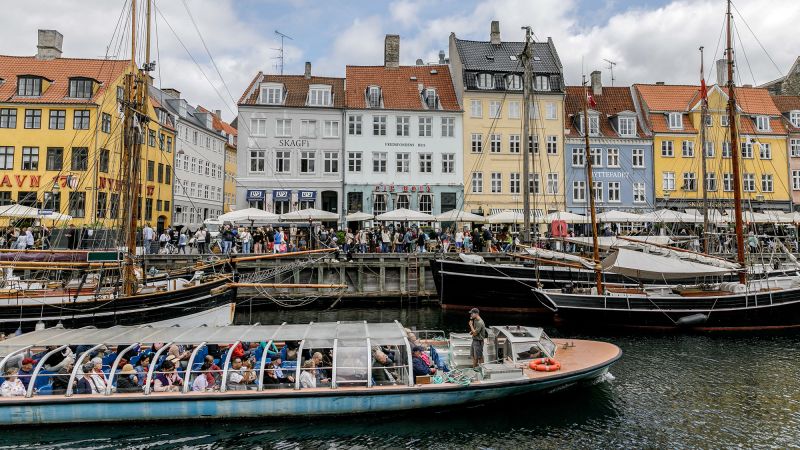CNN
—
It’s official. Vienna is no longer the most liveable city in the world.
After a three-year run at the top of the annual list from the Economist Intelligence Unit (EIU), the Austrian capital has been beaten out by “Wonderful, Wonderful Copenhagen.”
Denmark’s capital has taken the number one spot on the ranking of the world’s most liveable cities for 2025, which was released on Tuesday.
The EIU, a sister organization to The Economist magazine, ranked 173 cities around the world on a number of factors, including healthcare, education, stability, infrastructure and environment.
Copenhagen triumphed after receiving “perfect” scores for stability, education and infrastructure, while Vienna tied for second place with Swiss city Zurich.
Australia’s Melbourne retained its fourth place spot, while Switzerland’s Geneva was fifth on the list.
Just outside of the top five, Sydney, Australia moved up the list, jumping from joint seventh place to sixth, while Japanese city Osaka and New Zealand’s Auckland tied for seventh place.
In ninth place, Adelaide was the third Australian city to make the top 10, while Canada’s Vancouver took the number 10 slot.

So why did Vienna fail to come out on top this year?
Although the Austrian city scored well in most categories, its score in the stability category fell significantly, while Copenhagen scored highly in all sections.
The “sharp decline” in Vienna’s stability score was attributed to recent incidents, including a bomb threat at a Taylor Swift concert last summer, which led to the event being canceled.
“Global liveability has remained flat over the past year, and as in 2024, scores for stability have declined at a global level,” Barsali Bhattacharyya, deputy industry director at EIU, said in a statement.
“Pressure on stability has led Vienna to lose its position as the most liveable city after a three-year stint.”

However, Vienna wasn’t the only city that received lower marks for a category it had previously scored well in.
Calgary, which took fifth place in 2024, dropped out of the top 10 this year, falling to 18th after receiving a lower healthcare score, along with three fellow Canadian cities, due to a “strain” on the country’s healthcare system.
Toronto also placed lower this year, as a result, falling from 12th to 16th place.
“That’s really just reflecting the long waiting lists for medical checkups,” Bhattacharyya tells CNN Travel. “There’s been a shortage of staff at medical facilities and hospitals.”
Bhattacharyya stresses that other parts of the world have also been experiencing pressures on healthcare systems and housing infrastructure, but Canada “stood out” because of the sustained impact of these factors.
“Just to put that into context, they’re still some of the most livable cities in the world,” she adds.
Honolulu, Hawaii was the highest US city on the list, coming in 23rd place.
“We’ve seen a trend where sort of smaller or medium-sized cities in the US actually do a lot better than the really big cities like New York or LA,” explains Bhattacharyya. “And that’s largely because of the strains on public services infrastructure.”
Meanwhile, UK cities London, Manchester and Edinburgh also moved down the rankings after receiving lower scores in the stability category.
This follows a period of rioting and unrest in the UK last year after an anti-immigrant misinformation campaign stoked outrage over a stabbing attack in Southport, northern England.
This year’s list saw London drop from 45th to 54th place, Manchester from 43rd to 52nd and Edinburgh moving from 59th to 64th.

“As in 2024, stability scores have declined for western Europe and the Middle East and North Africa,” adds Bhattacharyya.
“In this edition, they have also declined for Asia, amid intensified threats of military conflict for cities in India and Taiwan.”
While some destinations fell down the list, others made significant gains, with Saudi Arabia’s Persian Gulf city of Al Khobar jumping 13 places from 148th to 135th.
The kingdom has made considerable investments to improve healthcare and education access under Vision 2030, an extensive plan to diversify its economy and reduce its dependence on oil.
Indonesia’s Jakarta also moved up the list, jumping 10 places from 142 to 132 thanks to an improvement in its stability core.
Unsurprisingly, the rankings at the very bottom of the list haven’t changed much in the past year, with Damascus, Syria still ranking as the least liveable in the world six months after the fall of ex-president Bashar al-Assad. Libya’s Tripoli ranked just above it.
Bangladesh capital Dhaka was third from bottom, while Pakistan’s Karachi and Algeria’s Algiers were ranked as the fourth and fifth least liveable cities.
While 2024 saw global liveability rise “fractionally,” this certainly hasn’t been the case this year.
“This is because of the declines in stability,” explains Bhattacharyya. “Because we have seen improvements in categories like healthcare and education, largely led by cities in the Middle East. But that has basically been offset by declines in stability.”
1. Copenhagen, Denmark
2. Vienna, Austria
2. Zurich, Switzerland
4. Melbourne, Australia
5. Geneva, Switzerland
6. Sydney, Australia
7. Osaka, Japan
7. Auckland, New Zealand
9. Adelaide, Australia
10. Vancouver, Canada

